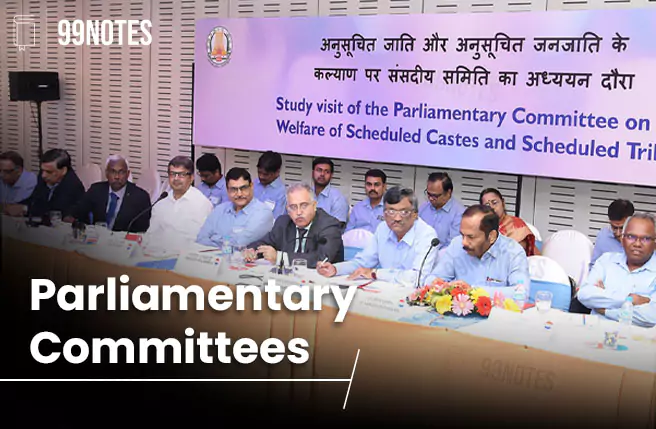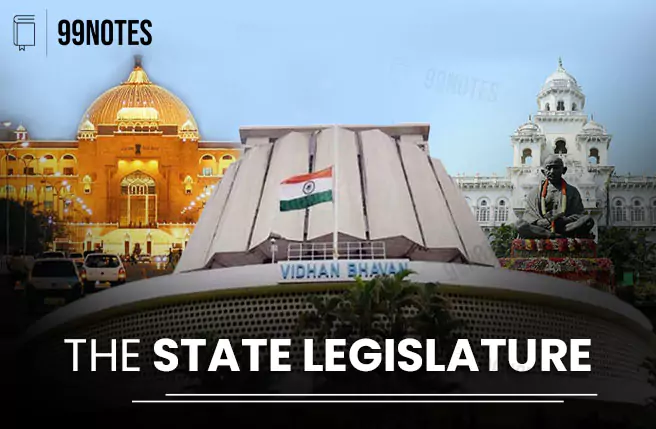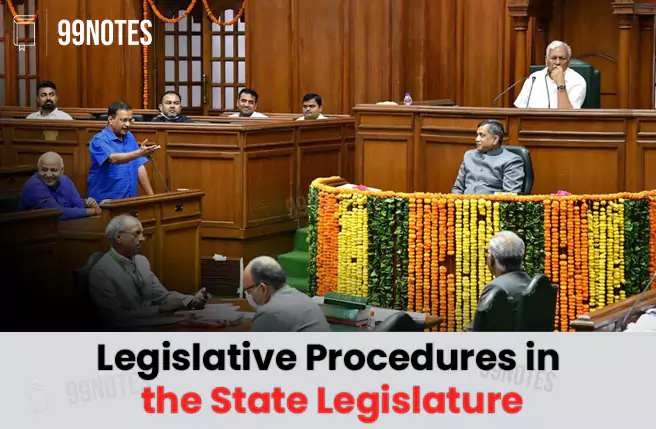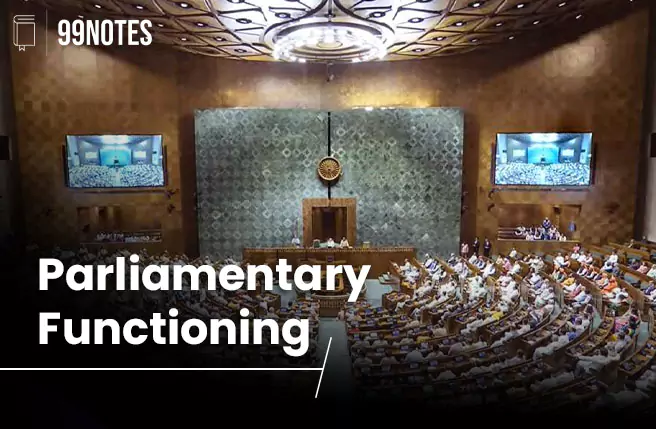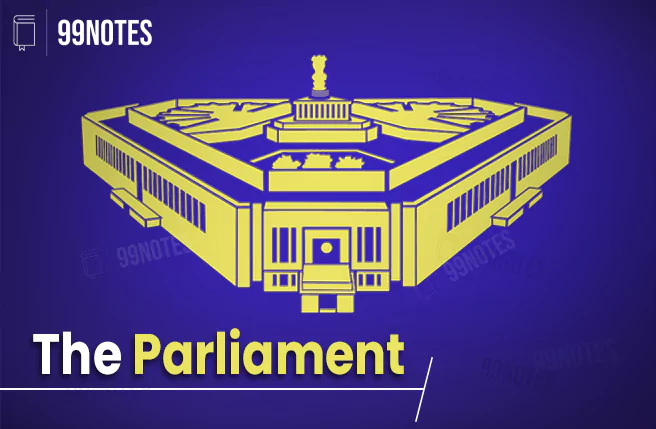Parliamentary Committees UPSC Notes
Members of Parliament need help to understand the complexity of the bills introduced in the House. Additionally, Parliament do not have enough time as they meet thrice a year, that too with a limited number of days there comes the role of parliamentary committees.
The parliamentary committees assist members of Parliament in discharging their duties and reducing the considerable workload of legislative matters that come up before Parliament.
What are Parliamentary Committees?
Parliamentary committees are groups of members elected or appointed by the House or nominated by the speaker, work under the speaker’s direction, present their report to the House or the speaker and have a secretariat provided by the House of Parliament.
Power and Authority drawn:
- The committees draw their authority from Article 105, dealing with the privileges of members of Parliament.
- Article 118 allows the Authority to make rules to regulate its Procedures and conduct of business.
By their nature, parliamentary committees are classified into the following categories:
- Standing committees
- Ad hoc committees
1. Standing committees:
The standing committees are permanent and regular committees that are constituted from time to time as per the provisions of an Act of Parliament of India or rules of Procedure and conduct of business in Lok Sabha. The committees consist of Members of Parliament.
The standing committees are classified into the following categories:
|
Committees
|
Sub-Committees |
| a. Financial committees | a. Public Accounts Committee |
| b. Departmental standing committees | A total of 24 departmental standing committees |
| c. Committees to Inquire | a. Committee on petitions
b. Committee of Privileges c. Ethics Committee. |
| d. Committees to scrutinise and control | a. Committee on Government Assurances
b. Committee on Subordinate Legislation c. Committee on papers laid on the Table d. Committee on Welfare of SCs and STs e. Committee on Empowerment of Women f. Joint committees on the office of profit. |
| e. Committees relating to the everyday business of the House | a. Business Advisory Committee
b. Committee on Private Member’s bills and resolutions c. Rules Committee d. Committee on Absence of Members from sittings of the House |
| f. House-keeping committees or service committees | These are Committees concerned with the Provision of various facilities and services to Members.
a. General Purposes Committee b. House Committee c. Library committee d. Joint Committee on Salaries and Allowances of Members. |
a. Financial committees:
Through these committees, the financial Accountability of the executive is ensured. There are 3 important standing committees dealing with financial affairs:
- The Estimates Committee
- The Public Accounts Committee
- The Committee on Public Undertakings
These are constituted under the Rules of Procedure and Conduct of Business in the states’ Lok Sabha or Legislative Assembly.
1. Estimate committee:
This Committee was set up to ensure the economy in spending money and efficient use of resources.
The estimates committee is responsible for undertaking a detailed examination of the budget estimates put forth by the union government.
Origin of the committees:
- The inception of the Estimates Committee of India can be traced to the standing financial Committee in 1921.
- In Independent India, it came into existence in 1950 with the inauguration of the constitution as the first Estimate Committee of India on the recommendation of John Mathai (then Finance Minister) under Rule 310 of Procedure and Conduct of Business of Lok Sabha.
Term of the office and composition:
- Term: The term of the office is one year.
- Members: It comprises 30 members only from the Lok Sabha (originally, it had 25 members but was raised to 30 in 1956).
- Election procedure: They are elected by the Lok Sabha from amongst its members, according to the principles of proportional representation, by means of a single transferable vote. Thus, all parties get equal representation in it.
- Representation: The Committee has no representation from the Rajya Sabha.
- Chairman: The Speaker of the Lok Sabha appoints the chairman of the Committee from amongst its members, and he is always from a ruling party.
- A minister cannot be elected as a member of the Committee.
Functions of the Estimates Committee are:
- Examines Budget estimates: The Committee proposes the efficient use of resources, analyses the estimates included in the budget, suggests economies in public expenditure, and prepares a plan for estimates.
- Suggesting Alternate policies: It suggests different other policies in place of the older one to bring economy and efficiency in administration.
- Scrutinised money utilisation: It Scrutinises whether the money is effectively laid out as per the limits of the policy implied in the estimates.
- Suggest a form in which the estimates will be presented in the Parliament.
- Continuous Examination: The Committee periodically examines the estimates and reports to the House as its examination proceeds.
Shortcoming:
- Postmortem Report: The Committee scrutinises the estimates of the budget only after the Parliament has voted on them and works like a postmortem.
- It cannot raise a question against the policy laid down by the Parliament.
- Advisory Recommendations: Its recommendations are only advisory and are not binding on the ministries.
- Examines selected Ministries and departments: By rotation, it would cover all of the ministries and departments over the years, as it examines only certain selected ministries yearly.
- Lacks Experts: It lacks the expert personnel of the CAG available to the Public Accounts Committee.
2. Public Accounts Committee:
The Public Accounts Committee (PAC) is accorded a pivotal role in ensuring financial Accountability and monitoring the government’s financial activities.
Origin:
- Public Accounts committees were set up in 1921 under the (Montague Chelmsford Reforms) Government of India Act, 1919.
- It was set up both at the centre and a provincial level to examine government accounts to detect any abnormality or deviation from rules and regulations, losses, delays, etc.
Term and composition:
- Term: The term of the office of the members is one year.
- Members: It consists of twenty-two members (15 from Lok Sabha and 7 from Rajya Sabha).
- Election procedure: They are elected by both the House of the Parliament from amongst its members, according to the principles of proportional representation, by means of a single transferable vote. Thus, all parties get equal representation in it.
- Chairman: The chairman is appointed from amongst its members by the speaker, and he has invariably been from the opposition since 1967.
- A minister cannot be elected as a member of the Committee.
Functions of the Public Accounts Committee:
The functions of this Committee are given below:
- Examines CAG’s Report: The Committee examines accounts and the report of the Comptroller and auditor general of India to ascertain that the funds appropriated by the Parliament have been spent with economy and efficiency.
The CAG submits 3 audit reports, i.e., an Audit report on appropriation accounts (the comparison of the actual expenditure with the sanctioned expenditure done in the appropriation account), an Audit report on Finance Accounts (finance accounts show the annual receipt and disbursement of the union government) and audit report on public undertakings.
- Thorough scrutinisation of Appropriation accounts and CAG’s Report on it: While examining the appropriation accounts and the audit report of the CAG on it, the Committee has to check whether the disbursed money was legally available for the applied service or purpose, whether the expenditure conforms to the Authority that governs it, reappropriation has been made according to the rules. authority
- Scrutinises the different aspects of tax administration: The Committee examines several aspects of the government’s tax administration involving cases like under-assessments, tax evasion, etc. It identifies the loopholes in the taxation laws and procedures and makes recommendations to check revenue leakages.
- Scrutinises accounts of different bodies: It examines the statements of accounts showing income and expenditure statements of state corporations, manufacturing and trading schemes and projects. It scrutinises accounts of autonomous and semi-autonomous bodies and audit reports by CAG on it.
Shortcomings:
- Conducts post-mortem examination of accounts. No corrective action can be taken after the financial decisions have already been taken.
- Its recommendations are not binding but advisory in nature.
- Cannot intervene in the matters of day-to-day administration.
- It cannot issue orders as it is not an executive body.
3. Committee on Public Undertakings:
The Committee on Public Undertakings is constituted every year for the examination of the working of the public undertakings.
Origin: The public undertaking committee was constituted in 1964 by the recommendations made by the Krishna Menon committee.
Term and composition:
- Term: The Committee was constituted for the period of one year.
- Members: It comprises 22 members (originally it had 15 members, but in 1974 it was raised to 22), 15 from Lok Sabha and 7 from Rajya Sabha.
- Election procedure: Members are elected by the Parliament of India from amongst its members according to the principle of proportional representation by means of a single transferable vote.
- A minister is not eligible for election to this Committee, and in any case, if a member of the Committee becomes a minister, he/she ceases to be a member of the Committee.
- Chairman: The chairman of the Committee is appointed by the speaker from amongst its members.
Function of the Committee:
- Examine the accounts and reports of the public undertaking mentioned specifically in the schedule.
- Scrutinise report of the CAG on the public undertakings.
- Examine if the activities of public undertakings are being carried out as per sound business principles and prudent commercial practices.
- Carry out any other functions of the public accounts committee and estimates Committee with respect to public undertakings.
Shortcomings and issues:
- It cannot examine the matters of day-to-day administration
- It cannot examine and investigate matters of government policy distinct from business or commercial functions of the public undertakings.
- The number of examinations of public undertakings is limited (not more than 12 in a year)
- The Committee works in the nature of a post-mortem.
- Its recommendations are not bindings on the ministers.
- It cannot examine and consider matters pertaining to government policies.
b. Department-related standing committees:
The Committee plays a key role in acting as a check and balance for the laws passed by the Parliament. The Committee meet to examine the expenditure of all ministries, bills referred to them, and policies or issues selected by them.
Origin of the Departmental Standing Committees: Seventeen department-related standing committees were set up in the Parliament in 1993 on the recommendation of the Rules Committee of the Lok Sabha; their number was raised to 24 in 2004.
These committees primarily look into three things:
- Bills
- Budgets
- Subjects issues for examinations.
Department-related standing committees and their Jurisdiction:
| Departmental Committees under Rajya Sabha | |
| Name of the committees | Ministries/Departments Covered |
| 1. Committees on Commerce | M/O Commerce and Industry |
| 2. Committees on Home Affairs | 1. M/O Home Affairs
2. D/O Development of the North-eastern region |
| 3. Committee on Education, Women, children, youth and sports | 1. M/O Education
2. M/O Youth Affairs and Sports 3. M/O Women and child development |
| 4. Committee on Industry | 1. M/O Heavy industries
2.M/OMicro, small and medium enterprises. |
| 5. Committee on science & technology Environment, forest and Climate Change | 1. M/O Science & technology
2. D/O Space 3. M/O Earth Science 4. D/O Atomic Energy 5. M/O Environment, Forest and Climate Change |
| 6. Committee on Transport and tourism and culture | 1. M/O Civil Aviation
2. M/O Road Transport & highway 3. M/O Port, shipping and Waterways 4. M/O Culture 5. M/O Tourism |
| 7. Committee on Health & Family Welfare | 1. M/O Health and family welfare
2. M/O Ayurveda, yoga and naturopathy, Unani, Siddha and Homeopathy (AYUSH) |
| 8. Committee on Personnel, Public Grievances, Law and Justice | 1. M/O Law and Justice
2. M/O personnel, public, grievances and pensions. |
| Committees under the Lok Sabha | |
| Name of the committees | Ministries/Departments Covered |
| 1. Committees on Agriculture, Animal Husbandry and food processing | 1. M/O Agriculture and Farmers welfare
2. M/O Fisheries, Animal Husbandry and dairying 3. M/O Food Processing Industries |
| 2. Committee on Communications and Information Technology | 1. M/O Communications
2. M/O Electronics & Information Technology 3. M/O Information & broadcasting |
| 3. Committees on Defence | M/O Defence |
| 4. Committees on Energy | 1. M/O New and renewable energy
2. M/O Power |
| 5. Committee on External Affairs | M/O External Affairs |
| 6. Committee on Finance | 1. M/O Finance
2. M/O Corporate Affairs 3. M/O Planning(NITI Aayog) 4. M/O statistics and Programme Implementation |
| 7. Committee on Consumer Affairs, food and public Distribution | M/O Consumer Affairs, Food and Public Distribution |
| 8. Committee on Labour, textile and skill Development | 1. M/O Labour & Employment
2. M/O Textiles 3. M/O Skill Development and Entrepreneurship |
| 9. Committee on Petroleum and Natural Gas | M/O Petroleum and Natural Gas |
| 10. Committees on Railways | M/O Railway |
| 11. Committee on Housing and Urban Affairs | M/O Housing and Urban Affairs |
| 12. Committee on Water Resources | M/O Jal Shakti |
| 13. Committee on Chemical & Fertilizers | M/O Chemical & Fertilizers |
| 14. Committee on Rural Development | 1. M/O Rural development
2. M/O Panchayati Raj |
| 15. Committees on Coal, Mines and steel | 1. M/O Coal
2. M/O Mines 3. M/O Steel |
| 16. Committees on Social Justice and Empowerment | 1. M/O Social Justice and Empowerment
2. M/O Tribal Affairs 3. M/O Minority Affair. |
Term and Composition:
- Term: The term of members of these committees is one year.
- Composition: Each of these standing committees consists of not more than 31 members, of which twenty-one are to be nominated by the speaker from amongst the members of Lok Sabha, and ten are to be nominated by the chairman of Rajya Sabha from amongst its members.
- A minister is not eligible for nomination.
The functions of these committees are:
- Examination of demand for grants: Consideration of demands for grants before they are discussed and voted in the Parliament.
- Examination of bills: Examination of bills referred to them by the speaker or the chairman, as the case may be.
- Consideration of annual reports of ministries and departments and report thereon.
- Consideration of national basic long-term policy documents laid down in the House and referred to the Committee by the chairman of Rajya Sabha or the speaker of Lok Sabha, as the case may be.
The required Procedure is to be followed by each standing Committee while considering the demand for grants and making a report thereon to the houses. After the general discussion on the budget in the House is over, the houses are adjourned for a fixed period:
- The Committee shall consider the demands for grants of the related ministries during the aforementioned period.
- The Committee shall make its report within the specified period
- The demands for grants shall be considered by the House in light of the reports of the committees.
- For each and every ministry, there shall be a separate demand for grants.
The required Procedure shall be followed by each of the standing committees in scrutinising the bills and making a report thereon.
- The Committee shall consider the general principles and clauses of bills that are referred to them.
- The Committee shall consider only such bills as introduced in Lok sabha or rajya sabha and referred to the chairman or the speaker.
- The Committee shall consider the general principles and clauses of such bills and shall make a report thereon.
- Make a report on the bills within a specified period of time by the chairman and speaker.
The merits of department-related standing committees are:
- Their proceedings are free from any party biases.
- The committees make parliamentary control over the executive much more detailed, in-depth, continuous, and comprehensive.
- The ministries or departments would ensure economy and efficiency in public expenditure.
- They can avail opinion of the experts and public to make the reports.
- The Rajya Sabha and opposition parties play a major role in exercising financial control over the executives.
c. Committees to Inquire:
These committees inquire into matters where the Presiding officer has a quasi-judicial power, such as on breach of privilege etc.
1. Committee on the petition:
- Composition: The Lok Sabha Committee consists of 15 members, while the Committee of Rajya Sabha consist of 10 members.
- Origin: The Committee on the Petition of Lok Sabha is one of the oldest committees of the House, constituted in February 1924.
- The functions of the committees are:
- The Committee scrutinise the petitions on bills and on matters of general public importance.
- To report to the House on particular complaints made in the petition referred to it after taking such evidence as necessary.
2. Committee of privileges:
- Composition: The Committee of Lok Sabha consists of 15 members, and Rajya Sabha has 10 members.
- Function: It examines every question involving a breach of privilege of the members of any committee or the House of the Parliament thereof referred to it by the House or by the speaker.
3. Ethics committee:
- Composition: The Committee was constituted in Rajya Sabha in 1997 and Lok Sabha in 2000.
- Function: To examine every complaint relating to unethical conduct of a member of the House of the People referred to it by the speaker and make such recommendations as it may deem fit
d. Committees to Scrutinise and control:
1. Committee on Government Assurance:
- Origin: The Committee is entirely of Indian origin in the field of parliamentary committees and was constituted in
- Composition: The Committee consist of fifteen members in the Lok Sabha and ten in the Rajya Sabha.
- Function: Timely scrutinise the promises, assurances and undertakings given by ministers on the floor of the House and report thereon.
2. Committee on Subordinate Legislation:
- The Committee was constituted in 1953.
- Composition: It consists of 15 members in each House of the Parliament.
- Function of the Committee: It scrutinises and reports to the House whether the powers to make rules, regulations, bylaws, schemes or other statutory instruments (orders) conferred by the constitution or provided by Parliament have been properly exercised.
3. Committee on papers laid on the Table:
- This Committee was constituted in 1975.
- Composition: The Lok Sabha committee has fifteen members nominated by the speaker, while the Rajya Sabha has ten members.
- Functions:
- It examines all the papers laid on the Table of the House by the ministers.
- It examines whether there has been compliance with the Provision of the constitution, rule or regulation, or act under which the paper has been laid.
4. Committee on Welfare of SCs and STs:
- Composition: The Committee consists of a total of 30 members, 20 elected by Lok Sabha from amongst its members in accordance with the system of proportional representation by means of a single transferable vote and 10 elected by the Rajya Sabha from amongst its members.
- Chairperson: The chairperson of the Committee is appointed by the speaker from amongst the members of the Committee.
- Functions:
- To consider the report submitted by the National Commission for the scheduled castes (SC) and the National Commission for the scheduled tribes (ST) under Article 338(5)(d) and 338A (5)(d),
- To examine the measures taken by the Union to secure due representation of the scheduled caste and scheduled tribes (ST) in services and posts under its control having regard to the provisions of Article 335
- To report on the working of the welfare programme for the scheduled caste (SC) and scheduled tribes (ST) in the union Territories.
5. Committee on Empowerment of Women:
- The Committee was constituted in 1997.
- Composition: The Committee consist of 30 members, of which 20 are nominated by a speaker and 10 are nominated by a chairman.
- Chairperson: The chairperson is appointed by the speaker.
- Functions:
- To consider the report submitted by the National Commission for Women and to report on the measures that should be taken by the union government to improve the status/ conditions of women.
- To report on the working of the welfare programmes for women.
6. Joint Committee on offices of profit:
- Composition: It consists of 15 members, of which 10 members are from Lok Sabha and five members from Rajya Sabha who are elected from amongst its members of the respective houses.
- Functions:
- To recommend whether persons holding such offices should be disqualified from being elected as members of the House of the Parliament or not.
- Examines queries relating to offices of profit received from members of Parliament, ministries, state government, union territory administration or institutions.
e. Committee relating to the day-to-day business of the House:
1. Business Advisory Committee:
- Composition: It consists of 15 members, including a speaker who is the ex officio chairperson. The members are nominated by the speaker.
- Functions:
- To recommend the time allotted for the discussion of such government legislative and other business.
- Regulates the programme and timetable of the House.
2. Committee on private members’ bills and regulations:
- Composition: It consists of fifteen members. The Rajya Sabha does not have any such committees.
- Chairperson: The chairperson of the Committee is the Deputy speaker.
- Functions: To allot time to private members’ bills and resolutions, to scrutinise private members’ bills seeking to amend the constitution of India before their introduction in the Lok Sabha and to examine all private members’ bills after they are introduced.
3. Rules committee:
- Composition: The Committee consists of 15 members, including the chairman.
- Chairman: The speaker is the ex-officio chairman. The speaker nominates members of the Committee.
- Function: to consider matters of Procedure and conduct of business in the House of the Parliament and to recommend any amendments or additions to the rules.
4. Committee on Absence of Members:
- Composition: The Committee consists of 15 members from Lok Sabha, and it holds office for one year. The members are nominated by the speaker.
- Functions: This Committee considers all the leave applications from members and examines cases where members have been absent for a period of 60 days or more without taking permission from the sittings of the House.
f. Housekeeping Committee:
1. General purposes committee:
- It was constituted for the first time in 1954.
- Chairperson: The speaker is the Ex-officio chairman of the Committee.
- Composition: The Committee consists of the speaker of the Lok Sabha, the deputy speaker, members of the panel of chairpersons, the leaders of recognised parties and groups in the House, chairpersons of all standing parliamentary committees of the Lok Sabha, and such other members as may be nominated by the speaker.
- The function of the Committee is to advise on such matters related to the affairs of the House as may be referred to it by the chairpersons from time to time.
2. House committee:
- Composition: The Committee consists of 12 members nominated by the speaker in the Lok Sabha.
- Term: The term of the Committee is one year.
- Functions:
- To deal with all the questions relating to residential accommodation for members.
- To exercise supervision over facilities for accommodation, medical aid, food and various other amenities provided to members in members’ residences and hostels in Delhi.
3. Library committee:
- The Committee was first constituted by an announcement made by the speaker in 1950.
- The Committee is constituted every year as per the rules of the Procedure and conduct of business in Lok Sabha.
- Composition: It consists of nine members, of which six are from Lok Sabha and three from Rajya Sabha.
- The speaker appoints the chairman of the Committee.
- Function of the Committee:
- To help members use the material available in the library and make use of the services of the staff provided therein.
- To consider and advise on such matters related to the library as may be referred to it by the speaker periodically.
4. Joint Committee on salaries and allowances of members:
- The joint Committee was constituted to frame different rules under the salaries and allowances of members of the Parliament Act 1954.
- Composition: It consists of a total of 15 members, of which 10 members are from Lok Sabha and five from the Rajya Sabha.
- Function: To frame rules for regulating the payment of salaries, allowances and pensions to members of Parliament.
The consultative committees:
- The Committee consist of members of Parliament and is not a parliamentary committee.
- The Committee provide a forum for informal discussion between the Parliament, ministers, senior officers of the government, etc., on the programmes and policies of the government and the manner of their implementation. The Ministry of Parliament constitutes these committees.
- Process:
- Consultative committees for various ministries/departments are normally constituted after the general election to the Lok Sabha and, as when necessary, thereafter and shall dissolve on dissolution of the Lok Sabha.
- Additionally, separate informal consultative committees of the members of the Parliament are also there for all the railway zones.
- Membership:
- The Maximum and minimum limit of membership on a consultative committee is 40 and 10, respectively, from both houses. In addition, a maximum of four members from both houses can also be nominated as permanent special invitees.
- The consultative committee for a ministry or department is not constituted if a minimum of ten members have not been given their option to be nominated on that committee.
- The membership of these committees is Voluntary and left to the choice of the members or leaders of their parties in their respective houses.
- Members of Parliament are nominated by the Minister of Parliamentary Affairs.
2. Ad-hoc committees (need-based):
- These are appointed for a particular purpose, and they cease to exist after completion of work assigned to them and submit a report.
- It can be divided into two categories, i.e., Inquiry committees and Advisory Committees.
a. Inquiry committees:
These are constituted to inquire into and report on specific subjects, either by the two Houses of Parliament on a motion adopted on that behalf or by the speaker/chairman of the house to inquire into and report on.
b. Advisory committees:
- It includes a select or joint Committee on bills appointed to consider a bill and report on that particular bill.
- Refer a bill to Committee: The House refers a bill to a select committee or a joint committee of the two houses as soon as it is introduced for a general discussion.
- Motion Adopted: A motion to this effect has to be moved and adopted in the House in which the bill has come up for consideration. If the motion adopted is for reference of the bill to a joint committee, the decision is conveyed or sent to the other House, requesting the members to nominate members of the other House to serve on the Committee.
- Amendment: A member of the Committee can move an amendment to various clauses. The evidence of associations, public bodies or experts can be referred by the Committee, and the Committee can submit its report to the House after the bill has been considered.
- Minutes of dissent: Members who do not agree with the majority report may give their minutes of dissent to the report.
Role and Functioning of the Parliamentary Committees:
Due to the scale of operations and voluminous information that the Parliament is required to undertake, it is not possible to take up all issues on the floor of the House. Thus, to delve deeper into matters of public matter, parliamentary committees are constituted.
Role of the parliamentary committees:
- In-depth analysis: Committees delve deeper into a specific piece of legislation, analyse and make appropriate recommendations.
- Check on executive: Committees help the Legislature to ensure oversight of the executive. For example, during the budget session 2023-24, reports tabled on the demand for grants highlighted certain inconsistencies on the government’s part. The Committee on Rural Development & Panchayati Raj, in its report, noted that the revised estimates always fell short of the budget estimates and the actual figures are always less.
- Prepares schedule of the houses: The Committee prepares (business advisory committee) the entire schedule of both houses and regulates the programme and timetable of the House.
- Parliamentary committees help in improving the effectiveness of Parliament.
- Closely Scrutinises legislation: The Committee closely examine proposed legislation, government policies, expenditure, and petitions from the public, check whether the rules framed by the government are in consonance with acts of Parliament, etc.
- Experts Help: Helps to get inputs from experts and stakeholders on several matters.
Evaluation of Functioning of the Committees:
- Decrease in the number of sittings: The Table given below shows the average number of sittings for 10 committees, which examine the largest by expenditure ministries or departments.
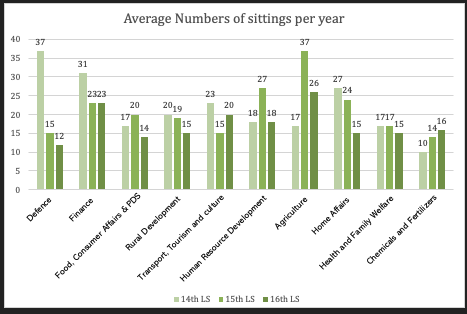
There has been a decrease in the average number of sittings of defence, Finance and Home Affairs while there has been an increase in the sittings of chemical and fertilisers committee.
- Insufficient time to study demands for grants: The DRSCs examine the demands for grants (detailed estimates of expenditure of each ministry) of all ministries after the budget is presented. The reports on demand for grants help members to scrutinise government expenditure better. Thus, it is essential to have sufficient time to study these reports before the discussion in the House. Still, as per the Ministry of Parliamentary Affairs, in many cases, members do not have sufficient time to study these reports.
- Less number of bills referred: The committees examine the bills as Parliament does not have the time and expertise to analyse the bills in detail on the House floor. However, as per the trend, lesser numbers of bills are being referred to parliamentary committees as compared to previous Lok sabha. For instance, in the 15th Lok Sabha, out of the total, 69% of the bills introduced were referred to the Committee, whereas, in the 16th Lok Sabha, only 21% of the bills introduced were referred to the Committee (as per the report published by Lok Sabha).
- Less number of recommendations accepted: The Committee on Public Undertakings examines the CAG’s reports of public sector undertakings and submits its report to Parliament. In 2018-19, 45 recommendations were made by it, out of which 73% were accepted by the government. In the past eight years, 67% of the recommendations made by the Committee have been accepted.
- Check and balance on government’s expenditure: The estimates committees report on pre-budget estimates, examine whether the proposed expenditure is within the limit of government policy and suggest the needed reform.
Way forward:
- Referring a bill to the Committee: Sending a bill to a committee is not mandatory; it all depends upon the decision of the speaker/chairman. However, referring all bills to a committee would ensure that all laws go through a minimum level of parliamentary scrutiny.
- Expert witness and research support: The members of DRSCs can consult with expert witnesses, stakeholders, and government officials; it will enable the members to understand the details of the issues better.
- Attendance of the members: the committees hold several meetings to conduct an in-depth analysis of several issues through extensive deliberation among the members. The success depends upon the participation of members in these meetings. On average, only 49% of members were present for meetings of the DRSCs between 2009-14.

